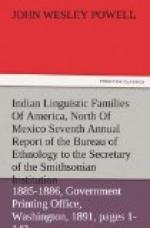The opinion that the differentiation of languages within a single stock is mainly due to the absorption of materials from other stocks, often to the extinguishment of the latter, has grown from year to year as the investigation has proceeded. Wherever the material has been sufficient to warrant a conclusion on this subject, no language has been found to be simple in its origin, but every language has been found to be composed of diverse elements. The processes of borrowing known in historic times are those which have been at work in prehistoric times, and it is not probable that any simple language derived from some single pristine group of roots can be discovered.
There is an opinion current that the lower languages change with great rapidity, and that, by reason of this, dialects and languages of the same stock are speedily differentiated. This widely spread opinion does not find warrant in the facts discovered in the course of this research. The author has everywhere been impressed with the fact that savage tongues are singularly persistent, and that a language which is dependent for its existence upon oral tradition is not easily modified. The same words in the same form are repeated from generation to generation, so that lexic and grammatic elements have a life that changes very slowly. This is especially true where the habitat of the tribe is unchanged. Migration introduces a potent agency of mutation, but a new environment impresses its characteristics upon a language more by a change in the semantic content or meaning of words than by change in their forms. There is another agency of change of profound influence, namely, association with other tongues. When peoples are absorbed by peaceful or militant agencies new materials are brought into their language, and the affiliation of such matter seems to be the chief factor in the differentiation of languages within the same stock. In the presence of opinions that have slowly grown in this direction, the author is inclined to think that some of the groups herein recognized as families will ultimately be divided, as the common materials of such languages, when they are more thoroughly studied, will be seen to have been borrowed.




